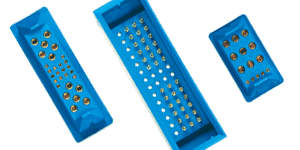Blind Mate Connector
Many of us have desks sitting up against an office or cubicle wall blocking access to electrical receptacles. So what happens when you get a new printer, desk lamp or the like? If you’re like most of us, you try and figure out how to reach the wall plug without moving your desk. This requires you to reach your arm into the tight space between the desk and the wall and attempt to plug the device in without seeing or feeling the wall receptacle.
In our world of electronic connectors, where you can’t see or feel the connector components, you risk making an incorrect and possibly unsafe attempt at mating. That’s when a blind mate connector can save the day. These multi-talented connectors ensure that flawless mating occurs when sight or touch is restricted or inhibited.
Blind Mate Connector Defined
Constructed with self-aligning features, blind mate connectors guide themselves into the correct mating position. They are needed for special assignments in which the electrical receptacle is recessed or hidden in a way that impairs its viewing and tangibility. Carefully designed to ensure consistent, reliable, precise performance, these connectors minimize the risk of misalignment. And they must be strong and resilient as well, so that if some mistreatment does occur, they will still be long lasting, reliable products.

Many different types of connectors come with blind mating options, including power/signal connectors with cable or board mount options. If designed well, the blind mating capability of the connector should not impair the connector’s size and weight greatly, adding only a slight amount of bulk.
Because the mating action takes place where you can’t see or feel it, a blind mate connector usually uses a non-threaded interlock or no locking system at all. Some blind mate connector varieties slide on, while others snap or use guide pins. When a blind mate connecter is designed well, they promote ease of use and add security to the action. This is integral because when connectors cannot be mated using normal visual clues and insertion techniques, the users must be extra certain that the connection is properly completed. This can be accomplished by auditory, tactile and/or visual indicators that the connectors are fully mated.
USES
A blind mate connector is put to good use in those tasks where visual and tactile tools are compromised. They are typically used on the back of interface cards that are plugged into a chassis, and commonly found in “black box” installations where space and access are very limited. These connectors are also used to connect optical signals because they have the ability to link fiber optics on a plug-in card to an optical back-plane or through an optical mid-plane. A blind mate connector can also provide electrical power or signals. They are used in applications such as wireless base station infrastructure equipment, microwave subsystems, test and measurement, medical equipment, navigation systems, and military radar and satellite communication equipment.
PRODUCTS
Positronic offers a number of blind mate connector solutions, including the Infinity, Goldfish, Scorpion, Low-Profile Scorpion, Power Connection Systems, Great Golden, AdvancedTCA (VPB Series) and some select D-subminiature products such as the Optik-D fiber optic connector. The Infinity and Goldfish families perform blind mating excellently, compensating for 7.62mm of misalignment for the Infinity and 2mm of misalignment for the Goldfish. Although some accessories do exist, D-subminiature connectors are not ideal for blind mate applications.
Learn about space connectors.
Find Your Sales Agent
We cannot locate a sales agent for the country you selected.
Please view our global locations and contact the facility that is most geographically near you.